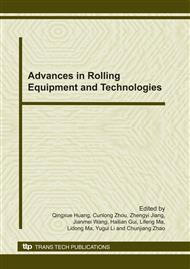[1]
V. B. Ginzburg: High-Quality Steel Rolling: Theory and Practice. Marcel Dekker, New York: Marcel Dekker, Inc. (1993).
Google Scholar
[2]
H. Matsumoto: ISIJ International, Vol. 31 (1991), p.550.
Google Scholar
[3]
S. I. Kobayashi. Inter. J. of Mech. Sci, Vol. 17 (1975), p.293.
Google Scholar
[4]
J. Sugiyama, K. Suzuki, H. Ishikawa: Journal of Japanese Social Technology Plasticity, Vol. 14 (1973), p.709.
Google Scholar
[5]
T. Ishikawa, M. Nakamura, Y. Tozawa: Journal of Japanese Social Technology Plasticity, Vol. 21 (1980), p.902.
Google Scholar
[6]
Y. Tozawa, T. Ishikawa, N. Iwata: Journal of Japanese Social Technology Plasticity, Vol. 23 (1982), p.1181.
Google Scholar
[7]
L. L. Yao. Journal of University of Science and Technology Beijing: Vol. 25 (2003), p.57.
Google Scholar
[8]
K. Mori, K. Osakada: International Journal of Mechanical Sciences, Vol. 26 (1984), p.515.
Google Scholar
[9]
I. Takahashi, H. Nagakura: Furukawa Review, Vol. 13 (1994), p.169.
Google Scholar
[10]
H. J. Huisman, J. Huetink: Journal of Mechanical Working Technology, Vol. 21 (1985), p.333.
Google Scholar
[11]
J. Yanagimoto, M. Kiuchi: Steel Rolling. Vol. 14 (1998), p.278.
Google Scholar
[12]
Z. Y. Jiang, A. K. Tieu: Journal of Materials Processing Technology, Vol. 112 (2001), p.144.
Google Scholar
[13]
H. M. Liu, J. C. Lian: Chinese Journal of Mechanical Engineering, Vol. 7 (1994), p.91.
Google Scholar
[14]
Y. L. Liu, J. C. Lian: Asia-Pacific Symposium on Advances in Engineering Plasticity and its Applications, Hongkong, (1992).
Google Scholar
[15]
H. M. Liu: Three dimensional rolling theory and it's application. Science Press, Beijing, (1999).
Google Scholar


